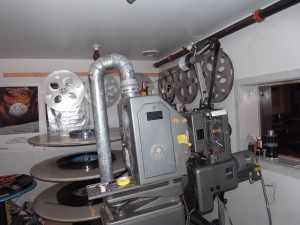Industry switch to digital projectors forces costly upgrade
By Stephanie Turaj; This article is reprinted with permission from The Block Island Times.
The lights look dim when it comes to keeping Water Street’s historic small theater afloat.

Empire Theatre, Block Island Ticket Booth
According to a 2011 Deadline report,Twentieth Century Fox International announced it would no longer release film prints to theaters in Hong Kong and Macau effective January 1, 2012. The only film content available to these foreign theaters will be in digital format. While this may seem like no big deal, Fox also announced that they would be phasing out film media in other markets “over the next two years,” reported Deadline.
What this means for local theaters, such as the Empire, is eventually, owners will be forced to buy digital projectors — or close their doors.
“There’s no way that theaters like us can swing this,” Pollard said. He estimated that 25 to 30 percent of independent theatres would close within the next year.
The Empire is in a different situation from Block Island’s Champlin’s Marina and Resort, which offers its small Oceanwest Theatre as part of its larger business. Owner Joe Grillo says they would hope to go ahead with the digital upgrade when it becomes necessary to do so. However, he did not comment on how he would fund the new projector. “It depends on when we have to upgrade,” said Grillo. “We’ll deal with that when the time comes.”
But Pollard doesn’t find the prospect of purchasing a new projector likely, and may be one of those to close within the next year, although he warns that nothing is finalized yet.
He would like to fundraise, but because the Empire is a private for-profit business, he worries that this may not be a viable option.
He added that the Empire’s seasonality and “transient audience” (which includes summer-only residents and visitors) would make it even more difficult to raise enough money.
If the Empire ceases to show films, Pollard has thoughts of turning the historic building into a combined video game room and retail booth area. The future remains uncertain, but as far as keeping it a movie theater and buying a digital projector without fundraising, “It just doesn’t make sense.”

Empire Theatre, Block Island Projection Booth
A digital projector is also needed to show films in 3D, another more recent technology trend, and Pollard said that adding 3D capabilities would tack another $20,000 estimate onto the projector price. However, he doesn’t see 3D as a huge issue, citing his belief that this is just an industry trend, not something he thinks will become a standard. “Right now, I’m just concerned about showing films in 2D,” he said.
“I’ve known this was coming,” said Pollard. “Everybody knew this was coming, but I don’t think we expected it to happen so quickly.” He thought that maybe the film distributors would still continue to supply 35mm film prints to qualifying small theaters like his, but this doesn’t seem to be the case.
“We’re a very small part of their market,” he added. For film distributors, making the switch to digital could save them thousands of dollars in cost and shipping per print. And according to a May 2012 Deadline report, another big reason for the shift is the rise in the price of silver, heavily used in film processing — prices raised from $5 an ounce to about $25 this year.

